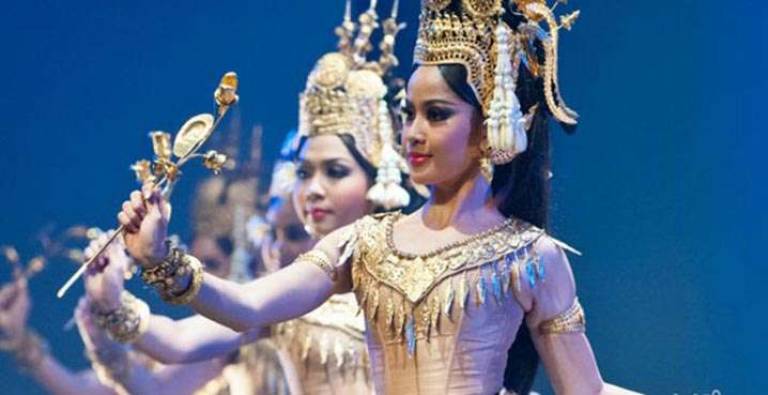The Season of Cambodia

Royal Ballet of Cambodia performs Apsara Mera at BAMusic
By Valerie Gladstone
Cambodian classical dancers move as slowly as rain sliding down a window, their hands curving and curling in intricate patterns as they look out into space as if enchanted by an unseen world. Supremely elegant in gold bangles and shimmering dresses and elaborate headdresses that replicate the ancient styles worn by women in the stone portraits in the temples of Angkor Wat, they resemble ancient goddesses more than mere mortals.
For over 1,000 years, young Cambodian women have trained in the difficult techniques that allow them to portray myths central to their culture. But rarely have they been seen away from home. Because of the wars and genocide that ripped the country apart from 1965 until 1991, killing hundreds of artists and because of the government's poverty, it was almost impossible for troupes to travel abroad.
"The Season of Cambodia" happening throughout the city is therefore a remarkable gift to New York, a wide-ranging introduction to the riches of this culture, which is meant to call attention to the vibrancy of the country, despite its painful history. Starting early this month and continuing through the end of May, the festival offers musical, dance and puppetry performances, film screenings, art exhibits, classes and discussions at the Asia Society, Works and Process at the Guggenheim, the Metropolitan Museum of Art, Parsons The New School for Design, the Mark Morris Dance Center and other venues.
But perhaps the jewel in the crown is the dance-drama "The Legend of Apsara Mera," which the Royal Ballet of Cambodia will perform at the Brooklyn Academy of Music May 2 ? 4. The two intertwined stories based on Hindu and Buddhist mythology and philosophy, one of creation and the other of love, show off Cambodian artistry in all its glory.
"It's not just a festival," says Phloeun Prim, CEO of the "Season of Cambodia" and executive director of Cambodian Living Arts. "It's a massive project celebrating three decades of revival and development of our culture after one of the worst genocides in the history of humankind. We've introduced a whole generation of Cambodians to their own history. The narrative has started to change."
Her Royal Highness Princess Norodom Buppha Devi, a star dancer in the Khmer tradition of Apsara in the 60's, encourages the change. Originally, the dances were only performed for gods and royalty; now they are presented to the public. Assisted by the few artists who were not killed by the Khmer Rouge, she teaches young women the stylized mime and intricate steps. The myths are already familiar, particularly the two that are the basis of "The Legend of the Apsara Mera," which she choreographed. As they speak of rebirth and renewal, they could not have more timely themes.
Royal Ballet of Cambodia performs "The Legend of Apsara Mera," at the Brooklyn Academy of Music May 2 ? 4.